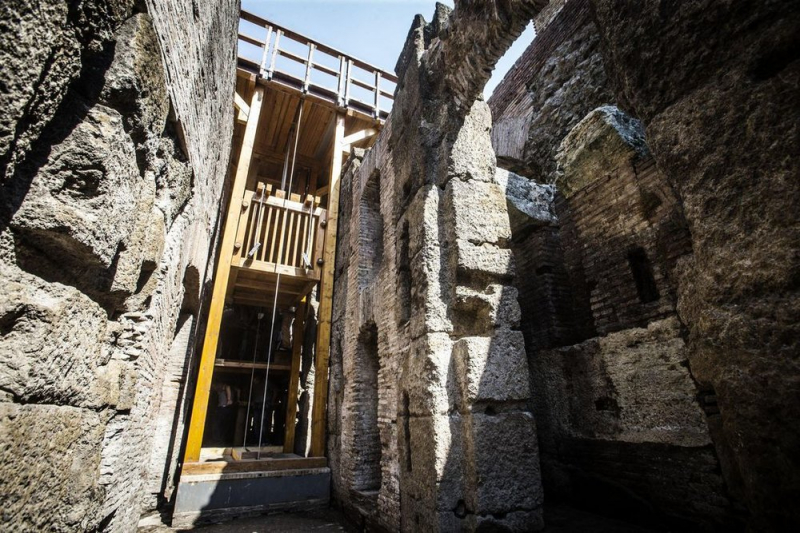Top 10 Interesting Facts You Might Not Know About The Colosseum
Colosseum is undeniable as the symbol of the city of Rome. With more than two thousand years of history, this place attracts millions of tourists each year and ... read more...has entered the hearts of Italian people. Colosseum represents heritage, strength, and prosperity. Learning about interesting facts you might not know about the Colosseum will help you better understand this important Roman monument.
-
Colosseum is not always called "Colosseum" because this modern name is only from the Middle Ages. Its proper name is Amphitheatrum Flavium or Flavian Amphitheatre, this becomes an interesting fact you might not know about the Colosseum. In fact, people can still see the original name written in the Roman arena today. The Flavian Amphitheatre was named after the Flavian dynasty, the emperors entrusted to build it. The actual name is Flavian Amphitheatre and is named after the emperor, Vespasianus Flavius, who built it. Although he died before he was completed, his son took over to complete the giant stadium, so the name was still Flavius or Flavian.
But, how did Colosseum have its modern name without holding the Flavian Amphitheatre name? The answer is still widely controversial among today's historians. 4 floors high and can accommodate more than 50,000 spectators, its unprecedented size may have created its vulgar name, "Colosseum". However, some historians believe that its name is involved in a "giant" bronze statue of Nero as the sun god used to stand outside. The name Colosseum does not originate in the Middle Ages. Some people believe that it comes from the phrase "Colis Eum?" Is translated as "Do you love him?" - this is said to have been asked at the nearby Nero statue, later associated with worshiping the devil.

Source: archeoroma.org 
Source: worldhistory.org -
Considering the speed of construction in Italy today, you may think that Colosseum takes a lot of time to build (or may even be abandoned). But the Roman workforce is strongly motivated, and it is built really quickly this is one of the interesting facts you might not know about the Colosseum. The Flavian dynasty had a huge working force of about 60,000 slaves brought from Jerusalem after the first Jewish War, who pulled the 20-mile Tivoli rocks to Rome. While manual labor is handled by slaves, the majority of skilled labor has been completed by the Romans by professional artists, engineers, architects, and decorators.
Colosseum was built really quickly thanks to certain mechanical skills also used: the crane of the tire running by the power of slaves in the basic thing is the wheel of the human, used to lift the materials needed to be needed. Set to build the famous stone dome of the Colosseum. Recent inventions on volcanic concrete also accelerate the construction process, allowing workers to combine effectively and effectively travertine stones, bricks, and other stones. Thanks to these slaves, the construction began under Vespasian around 70 or 72 AD and was completed about 8 years later when Vespasian's son, Titus, was inaugurated of Colosseum. To be correct, the last features were added when the other son of Vespasian, Domitian, added the top floor and the underground rooms for animals and fighters.

SSource: romeprivateguides.com 
Source: ancientromelive.org -
To restore the magnificence and glory of the Roman Empire, Vespasian built Colosseum to provide the public with a free entertainment place and feel appreciated. Each emperor organizes free for everyone and free games inside Colosseum as propaganda, aiming to lead the lavish and monumental battles to increase his popularity. Colosseum may contain 50,000 spectators (although some scholars estimate can be up to 80,000), making these games similar to some modern football games. This is indispensable in the list of interesting facts you might not know about the Colosseum.
When entering, the audience is broadcasting pieces of ceramic or stone as tickets to determine their seats and gates depending on their social status. The lower chairs in the stadium are for richer Roman families, some even have a private space like modern boxes. The remaining seats in the stadium are divided based on social status, with the lowest people in social levels in higher seats. To get in and out, each gate is numbered. There are 76 gates for the "usual" audience, and four other special gates - two gates for gladiators and two emperors. During the Roman period, social status was extremely important, and very detailed was included in the ticketing system to ensure that Nobile families and people were often divided at these free events. Historians believe that there has been "fighting" between games and servers that bring different food dishes to the audience including cakes, cheese, fruits and nuts, and even large glasses of wine! Historians have noted that there have been some cases of wooden balls falling from the sky filled with prizes such as desserts, money, and gifts. The more fun, eating and lavish, emperors are worshiped by the people thanks to free for everyone.

Source: britannica.com 
Source: wantedinrome.com -
This is an interesting fact you might not know about the Colosseum may surprise you, but most buildings and temples are repainted at that time. Travertine, limestone is used to make colosseum, is a porous rock. They used a technique called Scriptura, which basically meant that people covered a thin layer of mortar and marble dust to prevent rocks from worsening. Basically, this will give the original white pale or beige white. For the rest of the building, they painted the arches and all the statues to make the entire complex more vivid and more colorful.
During the restoration of the Colosseum in 2013, the restorers discovered the ancient colorful mural in a closed tunnel leading to civilian seats. After decades of not being touched, the restorers have brushed a layer of lime and dirt, revealing bright paintings with red, blue, green, and vivid white. They also found historic graffiti paintings left by the audience, such as crowns and palm trees. This led historians to believe that the tunnels inside Colosseum could be filled with paintings and colors during its original period.

Source: architecturaldigest.com 
Source: realmofhistory.com -
The Roman arena was built over a huge manmade lake. Before Vespasian was the emperor of Rome, the empire was ruled by Nero, a violent murderer, who built himself Domus Aurea, a golden mansion with a large artificial lake, taking away the public land. After emperor Nero committed suicide, emperor Vespasian built his Colosseum on the lake as a direct stab against his predecessor. He did this in a great effort to erase Nero's memory and to have loyalty and fame in building something for the people and re-establishing the glory of Rome. Cleaning the vast artificial lake of Domus Aurea two thousand years ago is not an easy task. Ancient engineers had to build canals to drain water from space. When doing this, they cleverly turned them into a sewage system, which is very useful for the days of the match when more than 50,000 spectators come to watch battles. These wastewater systems are connected to terracotta and lead pipes to the Tiber River. There is evidence of a really advanced water and wastewater system inside the Colosseum, including more than 100 fountains.
Before Domitian ordered the underground layer of the Colosseum, its floor and wooden racks could be removed, allowing the arena to be flooded. Ancient canals provided evidence that water was added to the arena for fake naval battles inside Colosseum, complete with fake warships. So if you can see the built over a huge manmade lake as one of the interesting facts you might not know about the Colosseum.

Source: britannica.com 
Source: theconstructor.org -
Colosseum has an elevator as one of the things not to be missed in the interesting facts you might not know about the Colosseum. Colosseum was not only the largest lecture hall in ancient times, but its technology was also modern at that time. When the young son of Vespasian, Domitian, became the emperor, he ordered the lower layer of the Roman arena, called Hypogeum. The bottom of this underground floor is larger than 6 models, and it contains a complex secret tunnel system to transport strange animals and gladiators under a mysterious curtain. There are two layers of the underground basement, and they lead to other buildings outside Colosseum. Moreover, engineers have installed an advanced elevator system to transport gladiators and animals from the underground to the arena. They are often operated by humans with ropes and pulleys, allowing the change of landscape to seem immediately in the arena. For larger animals like elephants, a hinge pedestal was invented by Roman engineers to lift them into the arena. There are a total of 36 traps, adding special effects and excitement at this time when support, wildlife, or gladiator seems to appear miraculously from nowhere.
Entertainment inside Colosseum lasts for hours (sometimes even days), and special effects with the highest quality and important level. For slavery, never a lack of manpower and engineers who worked tirelessly to ensure that the Colosseum is always updated as possible. In fact, there is evidence that Hypogeum has been renovated 12 times. The elevator plays an important role in providing entertainment services that Roman emperors expect.

Source: elevatorscenestudio.com 
Source: elevatorscenestudio.com -
The battles of the Roman gladiator fights are a means for emperors and have the privilege to show their wealth to the masses, recognize the military victory, and mark important visitors, birthday anniversaries, or just a resting step from political and financial issues during the day. People generally love the excitement of battles held in large places throughout the empire, with the Colosseum being the biggest arena of them.
There are usually 50,000 spectators from all Roman society members to enjoy the matches of gladiator fights in the Colosseum. The wild and strange creatures have been fighting, prisoners are executed, religious enthusiasts are thrown to the Lion, and the warriors use all their military power to fight to the death, and Roman's excellence and strength are honored. Many blockbuster films have been inspired by the history of the battles in this lecture hall such as gladiator, accidentally not even filmed in Rome, but in the context of Tunisia's different areas. This shows a unique tradition in interesting facts you might not know about the Colosseum.

Source: graylinerome.com 
Source: througheternity.com -
Colosseum is the world’s largest amphitheater. It is 189 meters long, 156 meters wide, and surprisingly higher than 50 meters, this is one of the interesting facts you might not know about the Colosseum. Visitors can see it in all its glory when they buy the official Colosseum ticket to visit it, whether discovering Rome at night or daytime. In fact, Colosseum was chosen as one of the 7 new wonders of the world in 2007.
Colosseum is famous for being the world’s largest amphitheater. This place is twice as long as a football field. In addition to the abundant and historical shows, Colosseum is famous to visitors because this ancient arena is the largest in the world. At the highest point, the Roman arena is 157 feet higher. It has the same height as the Washington Monument. Colosseum has four levels and in ancient Rome, more than 50,000 spectators can go through 80 entrances. When you are there, look for the diagonal to split the edge of the lecture hall. An earthquake shook the location in 1349 and divided the facade. Colosseum is built on soft sediments, so the ground shakes more in the earthquake.

Source: theconstructor.org 
Source: education.nationalgeographic.org -
Colosseum is used for botanical studies. In the 20th century, Roman rulers were affected by the gardening trend of the upper class, he had a blue fingers and began to grow roses and other strange flowers between the ruins, the place of development. Prosperity in spring waters. Therefore, Colosseum has become a place unlike anywhere else, not only showing its birth and decline but also showing history from the brutal destruction to the lavish fruit. Nowadays, it is open to tour guides and visitors can see 1,000 types of plants growing on old walls.
It is not clear how many of these species have come there, but a talk by Edward Salisbury, Director of Royal Botanical Garden in Kew during World War II, can clarify this. Discussing the riots of wildflowers that appeared after the Blitz match, he talked about how Rosebay herb can dissipate 80,000 seeds during the time it flew up to the sky 20 meters, showing the ability of the grain The spread of wind is huge. Therefore, these botanical studies are also interesting facts you might not know about the Colosseum will bring unique and creative discoveries for everyone.

Source: artandobject.com 
Source: theatlantic.com -
The Colosseum is used for Mock Sea Battles. Colosseum is the context for things other than gladiator entertainment, such as public executions and legendary plays. The Romans regularly recreate military victories to celebrate, with free entry and food supply to visitors. However, perhaps the most magnificent scenes at Colosseum are battles held in the flooded arena that can be filled and empty quickly, called Mock Sea Battles - an interesting fact you might not know about the Colosseum.
The largest Mock Sea Battle was held at Colosseum in 80 AD. The ruling king Titus requested the lecture hall to be flooded and ordered to build flat bottom boats, the ideal type of boat for shallow water. Historical researchers still do not know exactly how these battles on the sea have been held, but the boats used are probably small copies of genuine Roman boats. The main battle at Colosseum involved 3,000 warriors and the battle between Athens and Syracuse took place. There is even a fake island built in the arena, where the marines landed and conducted their battles. The last naval battle in the history of the Colosseum was said to have been held in 89 AD and was organized by emperor Domitian.

Source: nationalgeographic.com 
Source: atlasobscura.com































